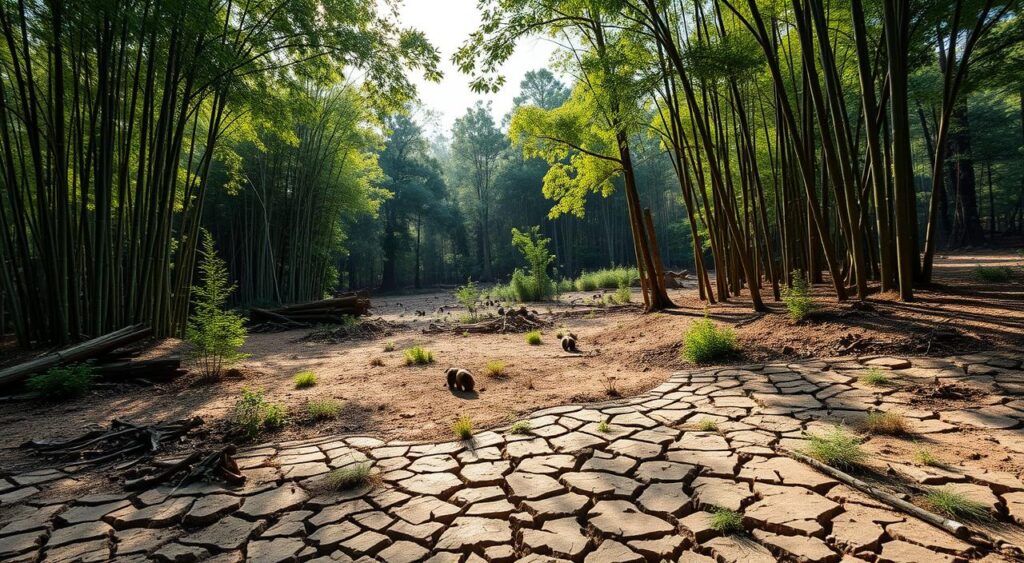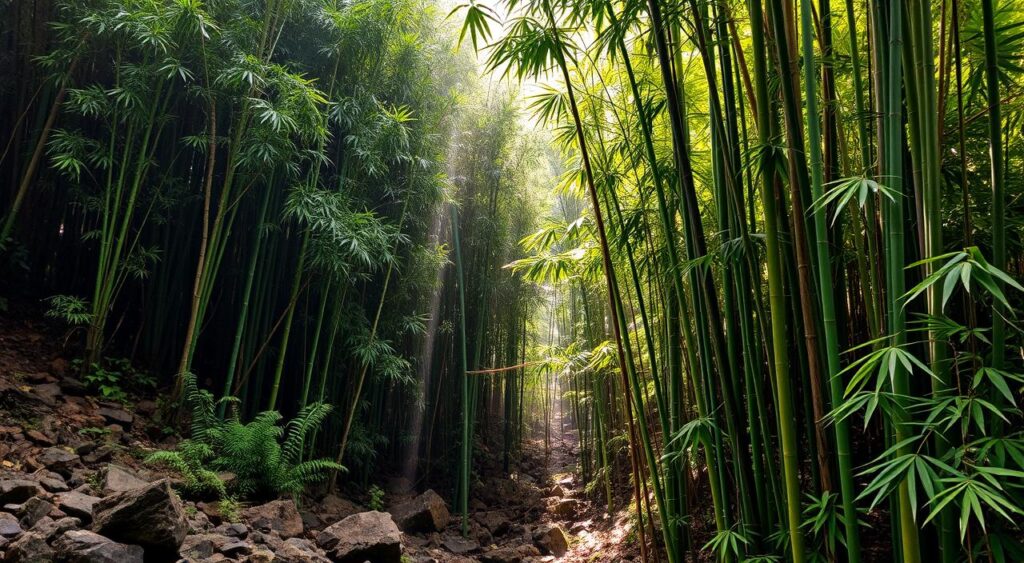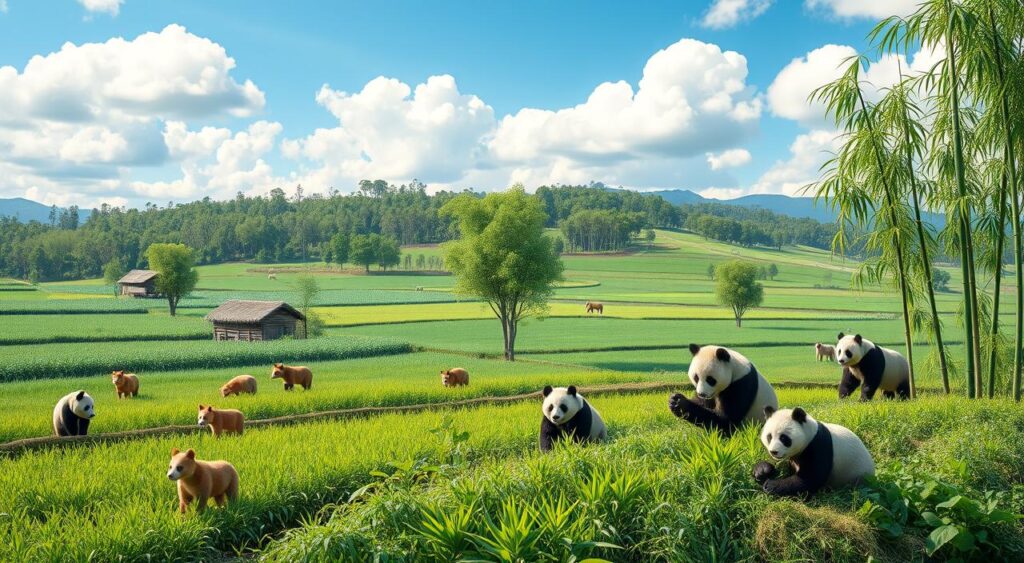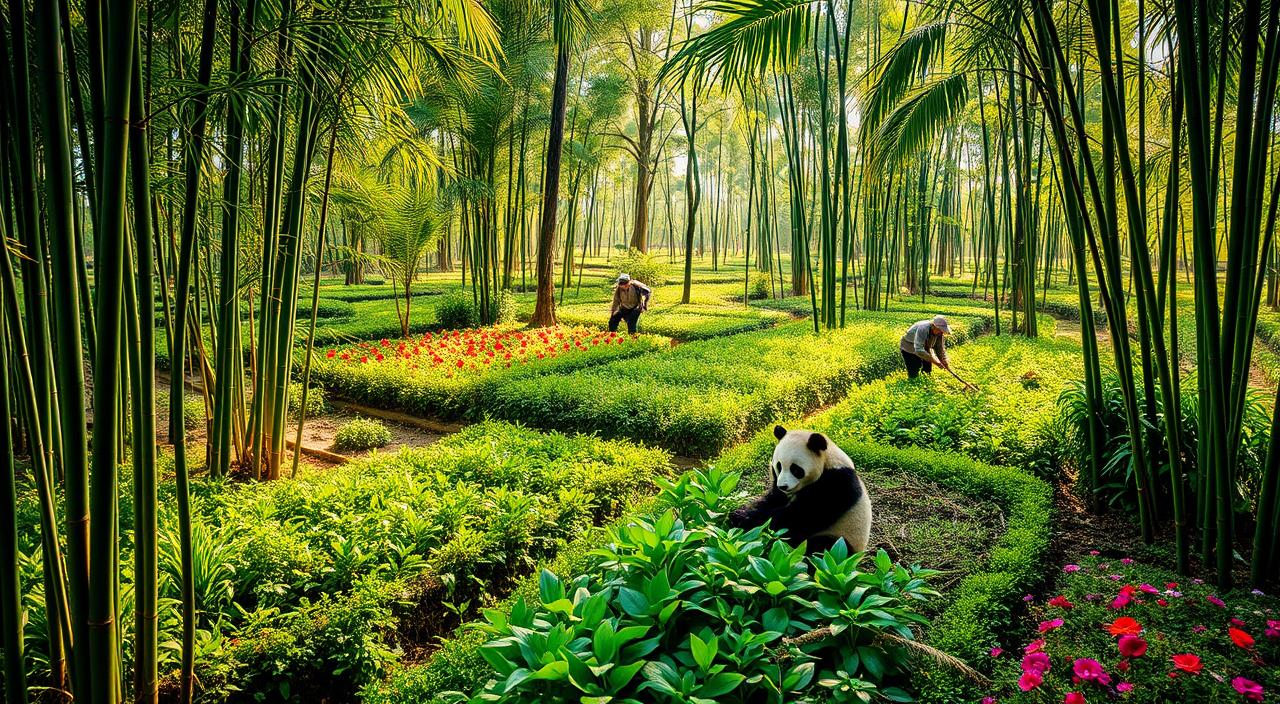In China’s bamboo forests, a special farming method is emerging. It focuses on saving the endangered giant panda. This approach not only keeps pandas safe but also helps the environment. It benefits both wildlife and local people.
These farms use bamboo, a key food for pandas. They are finding new ways to keep pandas and their forests together. This is a big step towards a better future for both.
Key Takeaways
- Panda-friendly farming practices aim to protect giant panda habitats while supporting local communities.
- Bamboo is a critical component of the giant panda’s diet, making its sustainable cultivation crucial for their survival.
- Reforestation efforts and the cultivation of bamboo in challenging environments help ensure a consistent food supply for pandas.
- Collaborative partnerships and stakeholder engagement are key to the success of panda-friendly farming initiatives.
- Sustainable bamboo cultivation can have a positive impact on both panda conservation and environmental sustainability.
The Importance of Bamboo in the Diet of Giant Pandas
Bamboo is key to the giant panda’s diet, making up 99% of their food. This is because of their unique diet and digestive system. Bamboo gives them the nutrients and fiber they need to stay healthy.
Specialized Digestive System of Pandas
Pandas have a special gut that helps them digest bamboo. This lets them get nutrients from bamboo. It shows how pandas have adapted to eat mainly bamboo.
Nutritional Benefits of Diverse Bamboo Species
Pandas get different nutrients from different bamboo species. This variety is important for their health. It helps them survive and thrive in the wild and in captivity.
“Giant pandas need to consume approximately 20 to 30 pounds of bamboo daily due to its low nutritional value.”
Challenges Faced by Pandas Due to Bamboo Dependence

Giant pandas rely heavily on bamboo, which is their main food. But, human actions like deforestation and urbanization harm their homes. This leads to habitat loss and fragmentation.
This makes it hard for pandas to find bamboo, which is 99% of their diet. The loss of habitat and the disruption of bamboo access threaten their survival. It also affects their ability to get the different bamboo types they need for nutrition.
Habitat Loss and Fragmentation
There are less than 1600 giant pandas left in the wild. They live in small groups, facing threats from human activities. Roads, dams, mining, and tourism harm their homes.
Climate change is also a danger to pandas and their habitats. It could further threaten their numbers and homes.
Bamboo Life Cycle and Food Shortages
The bamboo life cycle adds to the pandas’ challenges. When bamboo flowers and dies, it causes food shortages. In zoos, pandas depend on humans for food, making it key to manage their bamboo intake.
It’s important to balance bamboo availability, habitat preservation, and dietary management. This balance is crucial for the giant panda’s survival.
“The encroachment of human development into panda habitats not only reduces the area where bamboo can naturally grow but also disrupts the pandas’ ability to access different bamboo species critical for their nutrition.”
Reforestation Efforts to Ensure Bamboo Supply

Sustainable bamboo reforestation projects are key to keeping giant pandas fed. Organizations like Pandas International help replant bamboo in damaged areas. They choose bamboo species pandas love, aiming to feed them and restore their natural habitat.
Wolong Nature Reserve: A Successful Example
The Wolong Nature Reserve is a great example of bamboo reforestation’s success. It planted five bamboo types to feed local pandas. This not only helps pandas but also boosts biodiversity and supports local economies.
| Reforestation Statistic | Impact |
|---|---|
| Bamboo constitutes 99% of a giant panda’s food intake | Emphasizes the heavy reliance of pandas on bamboo for sustenance |
| Wolong Nature Reserve focused on planting five different types of bamboo | Showcases the diversity required for panda nutrition |
| Sustainable bamboo reforestation projects recreate natural habitats for giant pandas | Helps to preserve biodiversity and restore ecosystems |
| Bamboo farming contributes to preventing soil erosion and improving local environments | Enhances the sustainability of bamboo cultivation |
Working together is crucial for bamboo reforestation success. Conservation groups, local communities, and researchers must collaborate. This ensures pandas always have a steady food supply, helping them thrive.
Cultivating Bamboo in Challenging Environments

In Finland’s freezing temperatures, a special project is happening at the Ahtari Zoo. Finnish farmers are growing bamboo for the giant pandas. This shows how sustainable practices help in saving endangered species.
Jari Luokkakallio leads this effort with the help of about 50 local farmers. Together, they face Finland’s cold climate. They use their skills and new methods to grow bamboo for the pandas, like Hua Bao and Jin Baobao, or Pyry and Lumi.
This project is more than just food for the pandas. It shows the value of sustainable farming in saving endangered animals. The community is proud to be part of it, showing how projects like this can make a big difference.
“The collective efforts of our local farmers have been instrumental in creating a sustainable bamboo cultivation system that caters to the specific dietary needs of the pandas,” said Jari Luokkakallio, the agricultural advisor leading the project. “This initiative not only benefits the pandas’ nutrition but also brings a sense of community pride and joy to the region.”
The success of growing bamboo in Finland’s cold is thanks to the farmers’ hard work. Their project not only feeds the pandas but also shows how sustainable farming can solve big problems for endangered species.
Factors Influencing Bamboo Intake by Pandas

The bamboo intake of giant pandas is influenced by many factors. These factors are important for their nutrition and well-being. One key factor is the slope where the bamboo grows. Pandas like bamboo from sunny or semi-sunny slopes.
This shows that sunlight affects the bamboo’s nutritional value. This, in turn, influences the pandas’ food choices.
Slope Orientation and Sunlight Exposure
In the Liziping National Nature Reserve (Liziping NR) in Sichuan, China, the reserve’s elevation varies. It ranges from 1,330 to 4,550 meters above sea level. The annual average temperature is between 11.7–14.4°C.
The annual average rainfall is between 800–1,250 mm. In 2015, the Fourth National Survey found 22 giant pandas in Liziping NR. The pandas prefer bamboo from sunny or semi-sunny slopes.
This preference shows sunlight’s impact on bamboo’s nutritional value. It affects the pandas’ food choices.
Seasonal Variation and Nutritional Content
Seasonal variation affects the bamboo type consumed by captive giant pandas. The nutritional content of bamboo changes throughout the year. This is due to factors like temperature, sunlight, and precipitation.
This variation influences the pandas’ dietary preferences. Different bamboo species are favored in different seasons to meet their nutritional needs.
Bamboo Age and Felling-Feeding Time
Effective management of feeding behavior is crucial for panda nutrition and health. Bamboo age and felling-feeding time are important factors. They need to be carefully considered to meet the dietary needs of captive pandas.
By understanding and addressing these factors, conservationists and researchers can improve the well-being of captive pandas. They can do this through tailored dietary plans and habitat management strategies.
| Bamboo Species | Percentage of Giant Panda Feeding Bamboo |
|---|---|
| Arundinaria spanostachya | 38.08% |
| Yushania lineolate | 28.02% |
| Fargesia ferax | 12.48% |
Giant pandas in Liziping NR mainly eat A. spanostachya all year. They also eat Y. lineolate in winter and F. ferax occasionally.
Panda Friendly Farming

Efforts to ensure a stable bamboo supply for giant pandas go beyond immediate needs. They focus on sustainable cultivation practices. This benefits both captive and wild populations. The selection of specific bamboo species for planting in reserves aims to replicate pandas’ natural habitat and dietary preferences.
This step is crucial for preserving biodiversity and restoring the ecosystem. By cultivating a variety of bamboo species preferred by pandas, conservationists and researchers help the health of panda populations and their habitats. This work is a key part of their survival.
These efforts are a result of collaborative projects. They involve conservation organizations, local communities, and researchers. Their involvement is essential for the long-term success of sustainable bamboo cultivation.
Preserving Biodiversity and Ecosystem
Through shared knowledge, resources, and expertise, these collaborative efforts secure a continuous bamboo food source for pandas. They also create a sustainable balance between human activities and wildlife preservation. This approach helps maintain the delicate biodiversity and ecosystem that giant pandas depend on for their survival.
Collaborative Partnerships
The success of panda-friendly farming initiatives relies on collaborative partnerships between conservation organizations, local communities, and researchers. By pooling their shared knowledge, resources, and expertise, these stakeholders can develop sustainable cultivation techniques. These techniques ensure the long-term survival of panda populations and their habitat.
“The collaborative nature of bamboo reforestation projects underscores the importance of partnerships between various stakeholders for ensuring the long-term success of sustainable bamboo cultivation efforts.”
Sustainable Bamboo Cultivation for the Future

Efforts to keep bamboo supplies stable for giant pandas are growing. Now, we focus on growing bamboo in a way that helps both captive and wild pandas. Choosing the right bamboo species for reserves is key. It helps mimic pandas’ natural homes and food choices, while also saving biodiversity and fixing the ecosystem.
Selecting Bamboo Species for Reserves
By growing many bamboo species, we help pandas and their homes. There are over 1400 different species of bamboo worldwide. This means we can pick species that do well in panda reserves.
Involvement of Stakeholders
Working together is key in bamboo reforestation. Conservation organizations, local communities, and researchers all play a part. Their teamwork is crucial for the long-term success of bamboo growth. Together, they make sure pandas have a steady food supply and protect wildlife, even with climate change challenges.
Bamboo is a big help against climate change. It grows fast, takes in carbon dioxide, and stops soil erosion. By growing bamboo sustainably, we help pandas and their homes thrive for the future.
Also Read: Behind The Bamboo: Exploring Panda Breeding Programs
Conclusion
This article has shown how “panda friendly farming” helps the environment and protects giant pandas. We learned about the key role of bamboo in their diet and survival. It also highlighted the challenges they face because of bamboo.
Reforestation, growing bamboo in tough places, and understanding panda eating habits are key to saving them. These efforts involve many groups working together. This teamwork is vital for the long-term success of bamboo cultivation for pandas.
As we face climate change, keeping up with panda-friendly farming is more important than ever. It’s crucial for the survival and growth of giant pandas for many years to come.
The giant panda population is growing, thanks to conservation efforts. Over 60 panda reserves have been created. The IUCN even downgraded the species from “Endangered” to “Vulnerable” in 2016.
But, threats like habitat loss, climate change, and low reproductive rates still exist. These dangers remind us of the ongoing need for panda-friendly farming and environmental efforts.
FAQs
Q: How does panda friendly farming contribute to sustainable development?
A: Panda friendly farming contributes to sustainable development by promoting agricultural production practices that protect the environment, enhance biodiversity conservation, and support local livelihoods, while ensuring the protection of giant panda habitats.
Q: What are the key features of sustainable agriculture in the context of panda friendly farming?
A: Key features of sustainable agriculture in panda friendly farming include the use of organic farming techniques, integrated resource management practices, and regeneration strategies that minimize environmental impact and enhance ecological health.
Q: How can giant panda friendly products promote biodiversity conservation?
A: Giant panda friendly products promote biodiversity conservation by encouraging farming practices that protect panda habitats, support diverse ecosystems, and reduce habitat destruction, thus ensuring the survival of both panda populations and other wildlife.
Q: What role does pest management play in panda friendly farming?
A: Effective pest management plays a crucial role in panda friendly farming by using sustainable methods that minimize chemical use, thereby protecting water quality and the broader ecosystem, which in turn supports the conservation of giant pandas.
Q: How do harvest practices in panda friendly farming affect ecological balance?
A: Harvest practices that prioritize ecological balance, such as sustainable wild collection and careful management of harvest timing, help maintain healthy ecosystems and support the habitats where giant pandas thrive.
Q: What impact does the food and agriculture organization have on panda friendly farming?
A: The Food and Agriculture Organization (FAO) supports panda friendly farming by providing guidelines and resources for sustainable food systems, promoting practices that align with conservation goals and ensuring a sustainable approach to agricultural production.
Q: How does the pingwu shuijing tcm cooperative exemplify sustainable development?
A: The Pingwu Shuijing TCM Cooperative exemplifies sustainable development by integrating traditional Chinese medicine practices with sustainable agriculture, promoting the use of local resources while ensuring the conservation of panda habitats and biodiversity.
Q: What are the benefits of conservation areas in relation to panda friendly farming?
A: Conservation areas provide crucial benefits by preserving habitats for giant pandas, enhancing biodiversity, and offering a framework for sustainable land management practices that support both agriculture and wildlife conservation.
Q: How can consumers support panda friendly farming through their purchasing choices?
A: Consumers can support panda friendly farming by choosing giant panda friendly products, which encourage sustainable agriculture practices, contribute to biodiversity conservation, and help maintain the habitats essential for panda survival.
Q: What are some examples of sustainable wild collection practices in panda friendly farming?
A: Examples of sustainable wild collection practices include harvesting non-timber forest products in a way that does not deplete resources, ensuring that collection methods do not disturb panda habitats, and implementing guidelines that protect both the ecosystem and local livelihoods.

